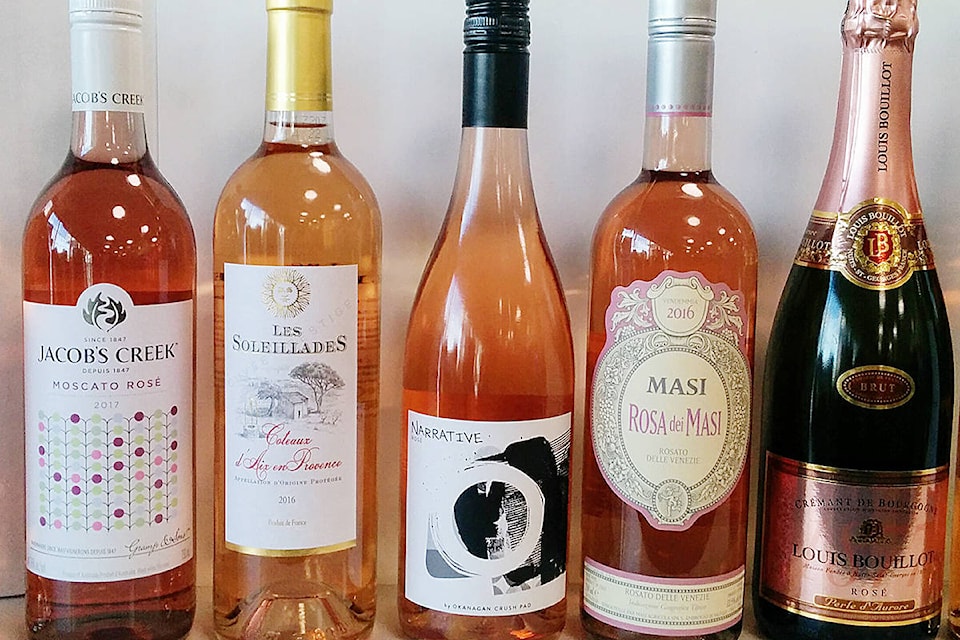Often subjected to derision and defamation of their vinous character, Rosé wines are made all over the world.
Thumb your nose at wine’s great unwashed, take a break from tradition and pair a Rosé with your Easter feast!
Based in the Yecla D.O. in south-eastern Spain, Bodegas Castaño specializes in wines made from Monastrell – known as Mourvédre in France and Mataro in Australia and California.
Light and ‘dry’, Castaño Dominio Espinal Rosado (617951) $9.99 is a remarkably affordable imported Rosé. Subtle aromas of strawberries morph into a delicately fruity profile on the tongue with flavours of tart cherries and spicy plum.
With a history reaching back to 1847 in Australia’s Barossa Valley, when William Jacob planted grapes along the banks of a creek that was then named for him, Jacob’s Creek is an iconic Australian winery. The first wines were made from these grapes in 1850.
Not just pink but also on the sweeter side Jacob’s Creek Moscato Rosé (745984) $12.49 suffers the further damning outrage of being ever so slightly fizzy. Drink this delicious Rosé well chilled to enjoy the raspberry and strawberry scrumptiousness that sizzles in every sip.
French Rosés from Provence along the Mediterranean coast are best known. Outside of Provence – but still in the south of France – winemakers in neighbouring regions manage to make great Rosés at a fraction of the price.
The cuvée of Les Soleillades Rosé (320069) $15.99 is a selection of the best fruit from the Coteaux d’Aix en Provence – a blend of 50 per cent Grenache, 40 per cent Cinsault and 10 per cent Syrah. With its bright, light pink colour, it tastes of crisp watermelon and delicate strawberries with a citrus twist over a deliciously ‘dry’ raspberry base.
Rosés can be made by mixing white wine grapes and red wine grapes and co-fermenting them together. In some regions Rosés are traditionally made by blending semi-finished red wines and white wines.
Other winemakers leave fermenting red wine grapes in contact with the grape skins for a very short time, until the developing alcohol strips some pink colour from the dark purple skins, then press off the pink juice.
Christine Coletta and Steve Lornie built Okanagan Crush Pad (OCP) in scenic Summerland, BC, on Switchback Organic Vineyard in 2011. Producing Haywire and Narrative wines, OCP has built a reputation as a premium winery winning unprecedented awards and accolades with chief winemaker Matt Dumayne at the helm.
Firmly built on a base of Pinot Noir, OCP Narrative Rosé (561464) $17.79 is exceptionally well balanced with tart lemon and grapefruit notes playing off an intriguing medley of subtle red cherry, berry aromas and flavours. Cool and crisp when chilled, this Rosé gets deliciously ‘dusky’ as it warms in the glass.
Think of Rosés as white wines with a serious case of red-berry attitude. Try them with a full range of different cuisines. While many benefit from some chilling, a sweat-frosted bottle usually means the Rosé in question is a little too cold to really flash its subtle fruit flavours!
Refosco is a very old family of dark-skinned grape varieties native to the Venetian regions of Italy as well as neighbouring areas of Friuli, Gavi, Trentino, Istria, and the Karst Plateau. Made from 100 per cent Refosco Masi Rosa dei Masi (764068) $17.99 has aromas of wild strawberries and some cinnamon spice. Pretty, with some rose petal notes.
Crémant de Bourgogne is the appellation used to describe white or rosé sparkling wines produced in France’s Burgundy. It is made using the same ‘Méthode Traditionelle’ that is used to create the more famous and much more expensive Champagnes.
A blend of Pinot Noir from Côte d’Or, Gamay from the south of Burgundy and Chardonnay from vineyards near the city of Mâcon, Louis Bouillot Perle d’Aurore Cremant de Bourgogne Rosé Brut (494856) $25.99 offers small red fruit notes – raspberries, redcurrants and cranberries.
Of course France’s most renowned Rosés come from Provence, some from the Côtes de Provence Sainte Victoire appellation.
Roughly equal amounts of Syrah and Grenache are blended with diminishing amounts of Cinsault, Rolle and Ugni Blanc in Chateau Gassier Le Pas du Moine Rosé (894964) $37.99 from Sainte Victoire. A medley of notes of blackcurrants, mango, lychee fruit, grapefruit and strawberry aromas and flavours emerge as this peppery wine warms and wakes up in the glass.
Reach WineWise by emailing douglas_sloan@yahoo.com
